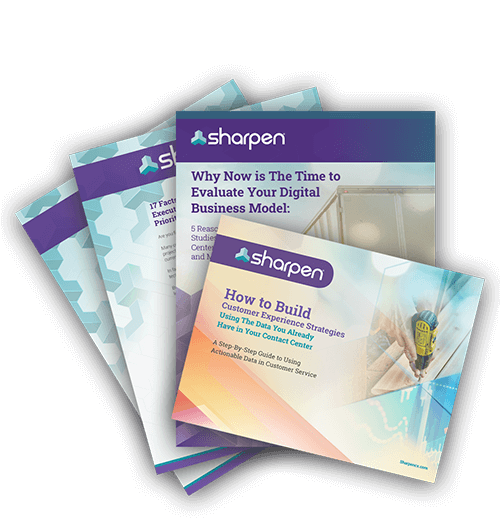
Can Proactive Customer Service Work For Your Call Center? 3 Ways to Anticipate Customer Needs and Act Faster to Put Bad Service in the Rear View
Last week when snow flooded the Indianapolis roads, delivery trucks had a hard time making it into neighborhoods. The mail was delayed a few days, Amazon trucks skipped their routes and FedEx tried to sludge through the unplowed streets.
Rather than let me longingly stare out my window (was I looking for the sun or a package?), one of the companies took a proactive approach to customer service.
I was waiting for a package (and the sun) when I got an in-app notification, followed by an email, letting me know my package wasn’t going to make it in the two-day delivery window. While I looked outside and assumed this truth already, I wasn’t left wondering.
[Download Now] Get your digital transformation toolkit to prioritize digital projects for better service
As soon as the company knew they couldn’t deliver, they set the right expectations with me. A problem popped up in my journey, and they acted on it. That’s what proactive customer service can look like.
But you don’t have to be a business giant to act proactively for your customers. Today, I’m talking about how you can realistically implement proactive customer service in your call center, no matter how big or how small.
What is Proactive Customer Service?
Proactive customer service is all about action. It’s customer service that uses knowledge of the customer journey to anticipate customer needs and offer solutions before issues lead to angry interactions.
Keep in mind, it isn’t practical to try to anticipate every customer need. Your customers will always have problems. Always. The realistic version of proactive customer service is finding a way to mitigate simple needs before they become a problem for your customers. Pairing a blend of proactive service (anticipation and action based on knowledge of the customer journey) with the reactive, transactional service that makes up the typical call center.
[Read Next] How to run an efficient inbound call center (without the crazy costs)
That might mean sending a notification before a problem occurs, like when shipping delays impact package arrivals or when your site will be down for maintenance. Or, it might mean using your data to recognize a customer who’s struggling, then reaching out to solve the problem rather than waiting until the customer reaches their tipping point.
Improve performance management and identify important customer trends with data to fuel proactive customer service
Almost 80% of your agents show up to work without knowing what’s expected of them. To kick off a cycle of proactive customer service, set clear goals and performance standards with your team. Then, use data to keep agents informed on their progress and how their metrics impact the customer service experience.
How to use performance data for proactive service:
- Choose three core metrics to measure for the quarter, and share those metrics with your agents. Make sure they understand why you chose these metrics and how they’ll be measured.
- Pinpoint metrics you can measure frequently. Sporadic reporting and once-a-month measurements won’t give you the intel you need to make clear decisions on how to improve customer service and agent performance.
- Make sure your agents have control over each metric. Metrics like Service Level and First Contact Resolution are tough for agents to influence. They can adjust how long they spend on phone calls and often they transfer calls to supervisors, but they can’t change how many of their peers call in sick or how many times a customer reached out for help prior to phoning them.
- Surface the metrics to your agents on a daily basis, and make it easy for agents to see how they’re performing against their goals (and even their peers).
How to use data to monitor customer trends:
Just as data gives you insight into how your agents are performing, it gives you a look at what your customers are doing, too. Use your data to get a view of your customer journey, so you can identify important trends and adjust your service models to prevent hiccups along the way.
A study by MyCustomer found nearly 90% of companies improved their customer service after mapping their customer journey. Many increased CSAT and NPS scores and even lowered churn.
Use real-time and historical data to track your customer journey with your contact center. Do you see a pattern with churning customers? Are your handle times on the rise? How about agent hold time? Are customers typically silent and suddenly flooding your surveys with complaints?
[Read Next] How to use data to inform your decision making this year
Maybe you even spot customers who’ve logged into their customer portal three times in the last month when they’re typically radio silent for months at a time. Your data has a story to tell. Look for triggers to understand your customers’ behavior across their journey.
Then, plug your data into predictive models to anticipate (some) future customer needs. Learn when your busy season hits, what day of the week you see spikes in interactions, and when customers typically reach out for help. (At a company I used to work for, it was all hands on deck every Tuesday). Then, plug all that info into an Erlang calendar to forecast for WFM and schedule the right number of agents during the right shifts.
Use your data and predictive modeling to set requirements for customer service levels, so you stay proactive and keep up with your customer’s needs.
Build omnichannel into your customer service strategy
I’ve talked about omnichannel again and again (and again). It’s just that important. Talking as a customer here, I seek out brands that don’t force me to pick up the phone. I loathe picking up the phone. So as you flesh out your omnichannel strategy, consider communicating with future customers in these three ways.
Live chat
Some 80% of customers say fast customer service is one of the most important pieces of a positive experience.
Trends show, modern customers prefer live chat over other channels, so investing in live chat support sets you up to serve the younger generations who are gaining tons of consumer power.
Self-service
Self-service gives the power back to your customers, helping them proactively problem solve without calling customer service.
Think through why your customers reach out for help. What questions pop up over and over again during interactions with your agents? Analyze call transcripts, emails, texts and chat messages to learn what prompts your customers to reach out for help. See what questions are repetitive and which ones customers could solve on their own with a little extra info. Flag those questions for your self-service portal.
[Read Next] 4 ways to improve your customer service with automation
Then, create guides, FAQs and self-help articles to answer the questions ahead of time for future customers. Then, they can come to your website or customer portal looking for answers and actually find them.
Social media
You can learn a lot about people by spending some time in the comments section on your favorite social channel (it’s a giant wormhole, don’t try it until after work). Use this knowledge trap to your advantage to deliver more proactive customer service.
Monitor top social channels for mentions of your brand to use social media as a tool for social listening, too. Here, you can learn what customers get excited enough to Tweet about and what frustrates them enough to pick up their megaphone and call you out. You can learn from all these customer mentions and reshape your service for the future. While answering and replying to customers on social is reactive (and so necessary!), learning from their feedback and applying it to future interactions is as proactive as you can get.
Scale coaching to develop your agents
Strategic Contact’s annual challenge & priorities survey said abandon rates, lack of coaching and development and high contact volumes are the top challenges plaguing 2021 call centers. Improving your coaching efforts can remedy all three.
Coach often
Build coaching into your daily workflow (or your supervisor’s). Lean on automation to help you ID what interactions need attention. Set thresholds for important metrics, like handle times, or even trigger words, like the word “cancel.” Then, jump into those interactions and leave in-line feedback. Calling out specific areas to improve on the interaction gives your agents the context they need to turn constructive feedback into action. Proactively identify issues and help your agents correct them, so they can deliver better customer service in their very next interaction.
[Read Next] 6 benefits to look for when choosing your next call center phone system
Hold creative exercises
In coaching sessions and team meetings, ask your agents to come up with solutions to common customer problems. Roleplay scenarios that pop up often, and throw some unexpected situations into the mix, too. Giving your agents the ownership to think freely and put their creative problem-solving skills to work will motivate them and keep them engaged. It’s easy to disengage when you’re given a list of orders and have no say in how you make an impact (your manager tells you what to do, then you do it). Engaged agents deliver better service. And, having more brains solving customer problems is always helpful.


